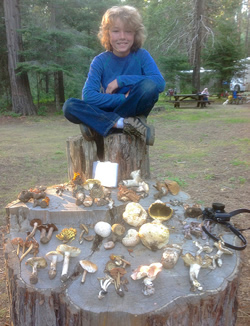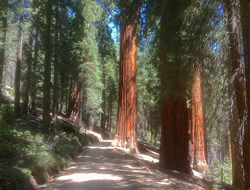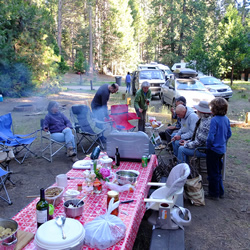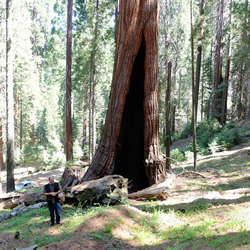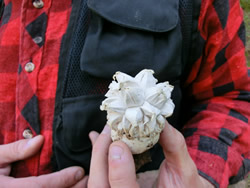BAMS Morel Foray
Eshom Campground, May 17-19, 2013
Eshom Campground is located in the Giant Sequoia National Monument at 4,800 feet in elevation. The habitat includes ponderosa pine, cedar, Sequoia and other conifers. We've heard that this is where David Arora conducted his first morel foray. To say that Eshom is in the middle of nowhere is an understatement. And the road up to General's Highway, while a short distance on your map or gps, is a bumpy mess. In between is the Whitaker Forest, a UC preserve, which we'd like to explore further.
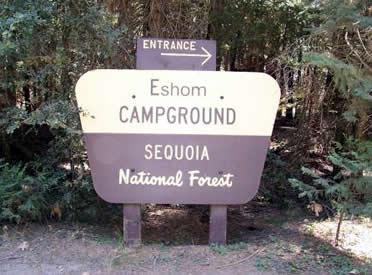
Photo courtesy US Forest Service |
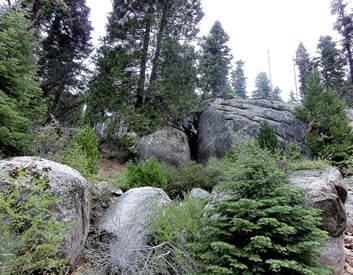
Rocky terrain where we hunted the elusive morel |
On Friday, David Rust, Brent Tindall and Debbie Viess scoured the local woods for likely spots to take the group. Unfortunately, a fire above Eshom did not show any morels despite a long wistful exploration. We did, however, find several good spots for three different species of morels. You have no idea how hard it was to walk away from those morels without picking them! Since we had no idea how rich the veins might be, we left them all.
Heading up the Whitaker Forest Road, we discovered a small seep/creek where we found the rare and beautiful Gyromitra (now Pseudorhizina) californica, with its pretty-in-pink stipe. This was the largest fruit body I had ever seen, both massive and highly fragile. I had not seen this species in the wild since our first trip to the area, back in 1998. Nifty find.
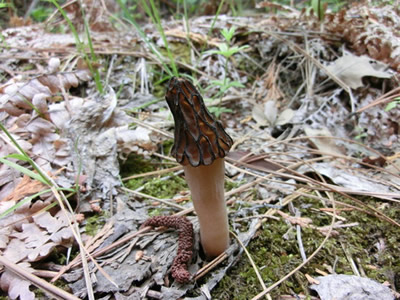
"Creekside" morel © photo by Debbie Viess |
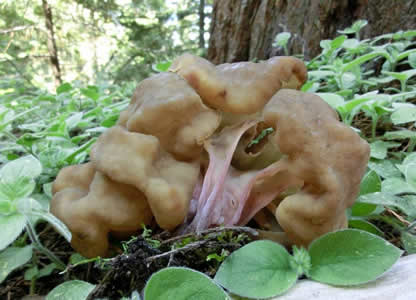
Rare Pseudorhizina californica at end of seep (below) in a ditch |
Further up that seep, in an otherwise fungally-free burn area, we found some of the curious mountain dwelling creek-side morels: tall (up to six inches or more!), with long, straight stipes and a rather insubstantial nature, at least compared to their blonde and black brethren. I spied a dozen beautiful fruit bodies right along the creek-side, and left them in place for those who would follow.
As we gathered at Eshom Campground, one new BAMS member walked out of the woods after just arriving at camp with her shirt filled with beautiful, pristine blonde morels. Score!
Blonde morels were popping at the lower elevations, where around three weeks ago or so, black Morchella snyderi were being collected. Even morels change with the seasons!
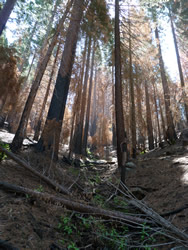
Seep in the fire zone where the |
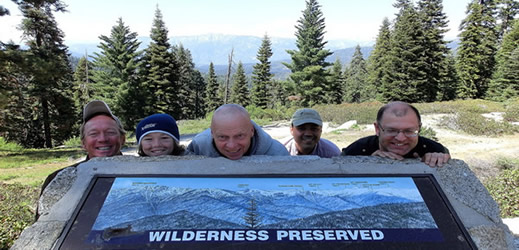
At the Kings Canyon lookout: Peter Bacon, Fletcher Bacon, David Rust, Michael Campos-Quinn, Peter Werner |
On Saturday, I encouraged young Fletcher Bacon and his Dad Peter, to climb on up (killer steep slope; send in the young folks!) and see how many they could find. I expected them back in minutes. An hour later they returned, with a big bag stuffed full! Guess that vein extended for days. These morels were actually fruiting in the water, as well as on well-rotted wood. Wish you guys had taken a photo! But your spoils were quite impressive, anyway. Everyone had a peek at that beautifully brimming bag.
Our common, mountain, non-burn morels, Morchella snyderi, were still fruiting at upper elevations, well buried, and covered in camoflacamouflagingollen. Aaaaaachoooo! You should have seen my rinse-water for those! Talk about yellow snow...
On Saturday night, the group was treated to a morel tasting, with three distinctly different species of morels, all drenched in butter and grilled over a fire: our local mountain blondes (latin name still in dispute), the creekside morels (ditto), and the Morchella snyderi. Yum. The rest of our potluck didn't suck, either.
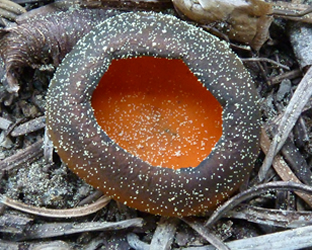
Caloscypha fulgens with pollen |
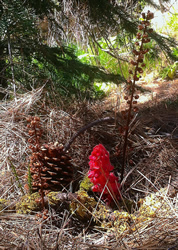
Mycoheterotrophs in the forest |
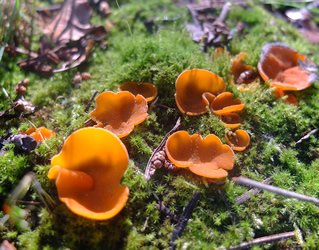
Aleuria aurantia in moss |
In this lush habitat, birds were well represented as well. We flushed a covey of the seldom seen Mountain Quail just outside of Kings Canyon and the General's Highway: a bit bigger than our California Quail, and with a tall straight topknot. White headed woodpeckers, Acorn woodpeckers, and Piliated Woodpecker calls and sign were everywhere, Olive Sided Flycatchers, perched at the very top of the very tallest snags, urged us on to our first, and third, beers (their call is typified as sounding like "Quick! Three Beers!"), Western Flycatchers, Rufous Crowned Sparrows, etc.
Binoculars, a must for we natural historians, are also useful to confirm mushrooms in the field before heading up (or down) a steep slope.
Wildflowers were also in profusion: Eshom Meadow was thick with Fivespots and many varieties of native grasses and rushes and sedges. There were white and purple and yellow violets, Western Wallflowers, Gilas, Spicebush, Chinese Houses, Sierra Onion, and on and on and on. It is a good year for Sierra wildflowers, despite this dry spring.
Mycoheterotrophs spotted: the pale pinkish, asparagus-like, young florescences of the Fringed Pinesap (Pleuricospora fimbriolata), parasitic upon Gautiera monticola, our familiar, bright red Snow Plants (Sarcodes sanguinea) and last year’s blooms of Pine Drops.
Although the majority of folks who showed up for this foray were looking for edibles and specifically morels (and we found them), we had a nice geek contingent, too: myself, Peter Werner, Arvid Ekenberg, who actually brought his dissecting scope! (very enterprising; too bad we were so pooped on Saturday night to do much more than sit and eat) and two budding mycologists: Michael Campos-Quinn and Fletcher Bacon.
 Morchella frustrata (yellow) Morchella frustrata (yellow) © photo by Debbie Viess |
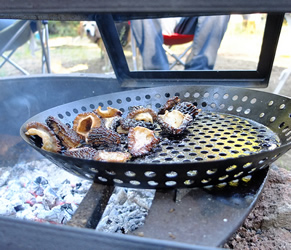 Black morels roasting Black morels roasting © photo by Michael Campos-Quinn |
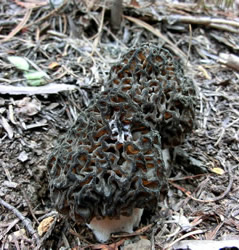 Morchella snyderi (black) Morchella snyderi (black) © photo by Debbie Viess |
Great to see all of the neat specimen mushrooms, displayed on our "Stump 'O Shrooms," and contributed to by all.
The Eshom area was a great favorite of the late Larry Stickney, and I can see why. In fact, I kind of felt like I was channeling Larry on this trip: not just while watching the embers of our campfire and remembering his adventures with the original Yosemite Fire-Fall, but because I was having pain and difficulty with my right knee and left leg, and needed to use walking sticks to stay steady. I almost considered staying home, but I asked myself: "What Would Larry Do?" Why, he'd suck it up and get two sticks and walk as slowly as he needed to, and get the job done. There's no tonic like a dose of natural beauty. Funny, mostly I felt just fine walking around. It was the getting down on the ground for photos and picking that made me scream (and this time, not in joy).
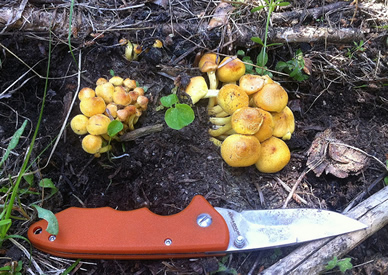 Sulphur tufts by day |
 Sulphur tufts by night |
BAMS morel foray 2013: Lots of diversity, lots of edibles, gorgeous scenery and perfect weather.
Good to get to know some of our more far flung BAMS members, too.
© Debbie Viess
Species List for Sequoia National Forest
- Aleuria aurantia
- Amanita aprica
- Amanita vernicoccora
- Boletus subtomentosus
- Bovista sp.
- Calbovista subsculpta
- Caloscypha fulgens
- Calvatia sculpta
- Clitocybe squamulosa
- Cortinarius sp. (Telamonia)
- Entoloma sp. (2)
- Floccularia albolanaripes
- Galerina sp.
- Geopyxis carbonaria
- Handkea fumosa
- Helvella lacunosa gp.
- Helvella acetabulum
- Helvella compressa
- Helvella leucomelaena
- Hygrocybe singeri
- Hygrophorus erubescens
- Hygrophorus subalpinus
- Hypholoma fasiculare
- Inocybe sp.
- Morchella frustrata (blonde morel)
- Morchella snyderi (black “natural” morel)
- Morchella sp. (creekside)
- Mycena acicula
- Mycena pura
- Pholiota sp.
- Pluteus petasatus
- Polyporus tuberaster
- Psathyrella spadicea
- Pseudorhizina (Gyromitra) californica
- Ramaria rasilispora
- Ramaria rubiginosa
- Sarcosphaera coronaria
- Trichaptum abietinum
- Tricholoma moseri
- Tricholoma sp.
- Tricholoma sp.
- Tricholoma vernaticum

